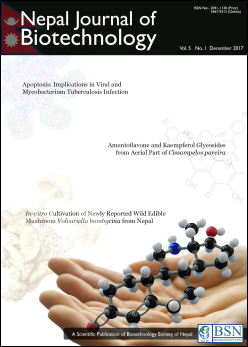Trichoderma species as Biocontrol Agent against Soil Borne Fungal Pathogens
DOI:
https://doi.org/10.3126/njb.v5i1.18492Keywords:
Biocontrol, Trichoderma species, inhibition percentage, soil borne pathogens and dual culture techniqueAbstract
Soil borne pathogenic fungi are of major concern in agriculture which significantly decreases the plant yield. Chemically controlled plant imposes environmental threats potentially dangerous to humans as well as other animals. Thus, application of biological methods in plant disease control is more effective alternative technique. This study was carried out to isolate Trichoderma species from soil sample and to assess its in vitro biocontrol efficacy against fungal pathogens viz. Sclerotium rolfsii, Sclerotionia sclerotiorum, Fusarium solani and Rhizoctonia solani. Biocontrol efficacy testing of isolates against different fungal pathogens was performed by dual culture technique.
In this study, 5 different Trichoderma species were isolated from 26 various soil samples and were tested against four fungal soil-borne pathogens. Inhibition percentage of radial growth of Sclerotium rolfsii by three of the Trichoderma isolates was found to be 100%; about 62% and 68% of maximum inhibition was observed against Rhizoctonia solani and Fusarium solani respectively whereas Sclerotionia sclerotiorum was inhibited maximum up to 23%. This in vitro study revealed that although Trichoderma species plays an important role in controlling all type of soil borne fungal plant pathogens, however, isolates as biocontrol agent against Sclerotium rolfsii was found to be more efficient in comparison to other pathogens.
Nepal Journal of Biotechnology. Dec. 2017 Vol. 5, No. 1: 39-49
Downloads
Downloads
Published
How to Cite
Issue
Section
License
Copyright Notice:
The manuscript submitted to NJB must be an original contribution, not previously published and should not be under consideration for publication elsewhere. When the manuscript is accepted for publication, the authors agree to automatically transfer the copyright of the article to the publisher. It should grant permission to any third party, in advance and in perpetuity, the right to use, reproduce or disseminate your article, according to the NJB copyright and license agreement.
Authors transfer copyright to the publisher as part of a journal publishing agreement but have the rights to: Share their article for Personal Use, Internal Institutional Use and Scholarly Sharing purposes, with the NJB applies the Creative Commons Attribution-NonCommercial CC BY-NC license to all the works we publish after Jun 2020 (Before it was CC BY-NC-ND). Under this license, authors agree to make articles legally available for reuse, without permission or fees, for virtually any non-commercial purpose. Anyone may remix, adapt, and build upon your work non-commercially, and although their new works must also acknowledge you and be non-commercial, they don’t have to license their derivative works on the same terms. More details on CC BY-NC refer to its Licence Deed and Legal Code.






